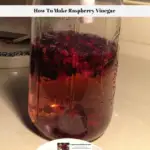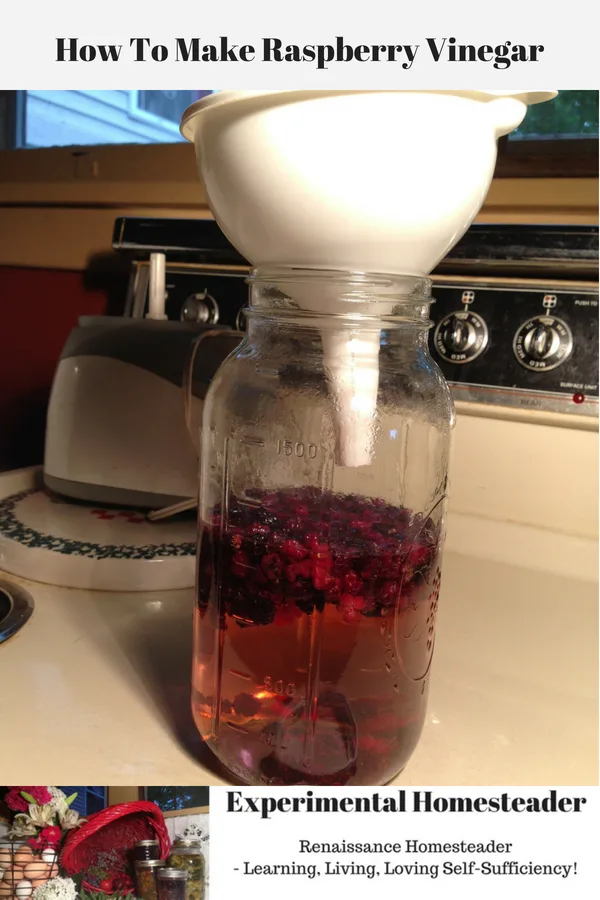Raspberry vinegar was the first flavored vinegar I learned to make.
The Story Behind The Raspberry Vinegar Recipe
The reason for that was I wanted to make Raspberry Pork Chops and I needed raspberry vinegar.
Up to that point, I had never tried a flavored vinegar.
In fact, I had never ate a raspberry.
The farm I lived on had a patch of raspberries at the edge of the woods.
I saw them one day and wondered what I could do with all that fruit.
It seemed such a waste to let it go bad on the vines.
I searched through one of my cookbooks and found a recipe for raspberry pork chops (I have altered it since then to suit me).
I picked as many raspberries as I could, made vinegar and made the pork chops.
They were a hit and I’ve been making raspberry vinegar ever since.
Here is how you do it – best of all, you only need to ingredients, fresh raspberries and white vinegar.
PrintHow To Make Raspberry Vinegar
Instructions
- Pick and wash the raspberries.
- Drain them and put them into a large glass jar. I use half-gallon canning jars.
- Bring the vinegar to a boil. You can do this over high heat if you wish.
- Remove from heat and pour the hot vinegar over the raspberries. Make sure they are completely covered.
- Put a non-metallic lid on the jar and sit it in a cool, dark, dry place. I use screw-on plastic lids now (you can find these in the canning section), but you can use plastic wrap and secure it to the jar with a rubber band.
- You can continue to add fresh berries. Just make sure they are covered with the vinegar. You can add more hot vinegar if necessary.
- After a month, I strain the liquid through cheesecloth. I squeeze as much liquid out of the raspberries the cheesecloth catches as I possibly can.
- Discard – or compost – the raspberries you strain out of the vinegar.
- The raspberry vinegar is now ready to use.
How To Preserve The Raspberry Vinegar For Winter Use
You can also can it to preserve it for winter use.
Here is how you do that.
PrintHow To Can Raspberry Vinegar
- Fresh raspberry vinegar
Ingredients
- Pour the raspberry vinegar into a stainless steel pan and bring it to a boil.
- Ladle the hot vinegar into the hot, sterilized jars.
- Wipe the rim, put the lid on the jar and tighten the band until it is fingertip-tight.
- Place the jars in a cold pack canner filled with boiling water.
- Process for 10 minutes.
- Remove the lid, turn off the heat and let the jars sit in the water for an additional five minutes, then remove the jars.
- Tighten the bands if necessary so they are fingertip-tight again.
- Allow the jars to sit overnight to cool, then check the lid by gently prying on it to make sure it is sealed. If it is sealed, label and store the jars in a cool, dry, dark place.
- Jars that are not sealed need to be checked to make sure there are no cracks or chips across the top of the jar. Do not reuse the lids if they do not seal – instead put a big black X on them and use them for sealing jars filled with herbs or other dried goods. You can use a new lid and try to reseal the jar or put it into the fridge and use it up.
[thrive_leads id=’437808′]
I highly recommend the following articles:
- Non-Alcoholic Copycat Painkiller Cocktail Recipe
- Basil Strawberry Watermelon Flavored Fruit Water
- Easy To Make Breakfast Macha Donuts Recipe
- How To Make Homemade Breakfast Tartlets
Use the buttons on the right-hand side of the screen to share this article with friends or family who might find it useful. Pin the picture below to your pinboard on Pinterest for future reference.






